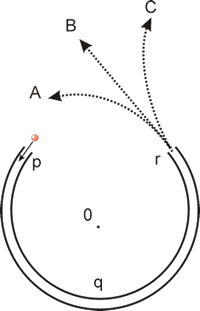An Introduction to Physics Education Research
- Page ID
- 4959
Overview
Physics teachers have long suspected that our beginning students hold many basic concepts about the physical world that are in conflict with the "scientific" worldview that largely originated with Kepler, Galileo, and especially Newton. In the early 1990's work began on developing diagnostic instruments to probe just how prevalent these misconceptions are and exactly what they are. A well-known example is the following question.
 A semi-circular track is fixed to a tabletop. In the figure, we are looking down on the track from above. A small ball is rolled at high speed into the track at point p. The ball rolls around through points q and r, and emerges from the track. Which of the paths A, B, C is closest to the path that the ball will follow?
A semi-circular track is fixed to a tabletop. In the figure, we are looking down on the track from above. A small ball is rolled at high speed into the track at point p. The ball rolls around through points q and r, and emerges from the track. Which of the paths A, B, C is closest to the path that the ball will follow?
Often a plurality or even majority of beginning physics students choose A. This fundamental misconception is deeply held by many students. When doing an actual demonstration, some students claim they actually saw the ball follow path A! I have placed a meter stick beside path B and repeated the demonstration and had students say "There must be magnets or something in the meter stick that caused the ball to follow path B, because before it followed path A."
The diagnostic instruments revealed many similar misconceptions. So they confirmed our suspicions.
The next step was to give the same diagnostic instrument to students at the beginning and again at the end of their physics course. The expectation was that we could then observe our grand success in having students replace wrong concepts with correct ones. However, the results of this pre/post test protocol was under whelming: the change in student understanding was minimal. So evidently conventional instruction is not very effective. Students learn to memorize formulae and on tests "plug and chug" to get correct answers, but the deep conceptual learning which we particularly value was not occurring in our classes. This depressing result has now been replicated for tens of thousands of students at a number of institutions around the world.
If conventional instruction is not effective, the diagnostic instruments allow us to conduct research to try to find pedagogy that actually works. After forming a baseline with the pre/post test protocol in a course, the following year make a change in the instruction and use the instruments to determine whether the change actually worked. This method of applying the scientific method to pedagogy is the heart of PER.
Some of the key results of PER are:
- Most students learn best by interacting with their peers. This result was particularly shocking to me. My preferred learning style is give me the textbook or journal article and a quiet corner and leave me alone! I suspect this is also the preferred learning style of many people who end up academics. However, it is not the best learning style for most of our students.
- The peer interactions are most effective when they are based on conceptually based activities. These activities are particularly effective when they force students to confront their misconceptions.
- The activities are particularly effective when they involve real physical apparatus. The apparatus need not be sophisticated or expensive: often materials available at minimal cost from the local hardware store can be effective.
Many skilled educators in a variety of fields have at least intuitively known these results. The difference is that PER allows us to quantitatively prove that these methods actually work.
PER is now a huge field of research. PER groups now exist in many physics departments, Physical Review has a Special Topics Section on PER, and googling "physics education research" returns 63,000 hits.
Applying PER
In this section I briefly describe how the results of PER are being applied in teaching physics.
Classes
Often we have up to 1000 students in a classroom. In conventional instruction we deliver a lecture to the students. We stand at the front of the room and deliver the "truth" which the students are expected to passively absorb.
The origins of the lecture is the middle ages, where the professor would come in to the classroom and read the book to the students. A few days later, the professor would again read the book to the students, perhaps adding some commentary. A few days after that he would again read the book to the students; this is the origin of the "third reading" which is still used in our parliaments. This type of pedagogy is perhaps appropriate if the professor is the only one with the book. However, the invention of the printing press in 1440 means that students also have the book. Thus the persistence of the conventional lecture can only be viewed as an anachronism based on habit, tradition, and perhaps just laziness.
Given that students learn best by interacting with their peers, how can this fact be implemented in a classroom with many students? One technique is called Peer Instruction (PI), whose greatest proponent is Eric Mazur at Harvard. Here is how Crouch and Mazur describe the method:
A class taught with PI is divided into a series of short presentations, each focused on a central point and followed by a related conceptual question, called a ConcepTest which probes students’ understanding of the ideas just presented. Students are given one or two minutes to formulate individual answers and report their answers to the instructor. Students then discuss their answers with others sitting around them; the instructor urges students to try to convince each other of the correctness of their own answer by explaining the underlying reasoning. During the discussion, which typically lasts two to four minutes, the instructor moves around the room listening. Finally, the instructor calls an end to the discussion, polls students for their answers again ( which may have changed based on the discussion), explains the answer, and moves on to the next topic.
("Peer Instruction: Ten years of experience and results," Am. J. Phys. 69(9), 970 - 975, (Sept. 2001),
http://web.mit.edu/jbelcher/www/TEALref/Crouch_Mazur.pdf)
Demonstrations
Physics classes often have demonstrations, and students love them. However, research shows that they don't actually learn very much from conventional demonstrations. Interactive Lecture Demonstrations (ILD) are an educationally effective modification of conventional demonstrations. In this method students make predictions of the outcome of a demonstration and collaborate with fellow students by discussing their predictions in small groups. Students then examine the results of the live demonstration.
Tutorials
At some institutions tutorials are known as recitation sections. A small group of students meets with a graduate student teaching assistant or in some cases the professor. In conventional instruction, these meetings allow for student questions and problem solving. Often they degenerate into mini-lectures by the TA or professor.
In modern PER-based instruction, most of the session is devoted to having students working in teams of 3 - 5 students on conceptually-based activities. The typical model is guided-discovery, in which the TA or professor uses a Socratic method where student questions are typically answered by another question. Devoting a small fraction of time to the conventional tutorial content is common.
In addition to the McDermott tutorial materials listed below in the Resources section, many textbooks now include Student Workbooks which provide activities for these PER-based tutorials.
Laboratories
We can characterize the goals of typical laboratory instruction as:
- Providing experimental illustration of the concepts of the course.
- Illustrating methods of experimental science, often including error analysis.
Typically a mixture of these two goals occurs in some proportion.
Goal 1 has considerable overlap with the PER-based tutorials.
Resources
Here I provide listings and links to resources to learn more about PER and how it is being applied. It is not exhaustive, but rather some personal favorites.
Introductions
Randall D. Knight, Five Easy Lessons:Strategies for Successful Physics Teaching (Pearson Addison Wesley, 2002), ISBN-10: 0805387021. ISBN-13: 978-0805387025.
Randy Knight is the author of the very successful textbook Physics for Scientists and Engineers (Pearson Addison Wesley). Here he discusses the theoretical basis for the way this text is constructed. I am not aware of a version available on the web, but your Pearson rep can supply a copy.
Edward F. Redish, Teaching Physics with the Physics Suite (Wiley, 2003), ISBN-10: 0471393789, ISBN-13: 978-0471393788
http://www2.physics.umd.edu/~redish/Book/
Although the title of this book indicates that it is an instructor's guide for a package of materials published by Wiley, it is also a lovely introduction to PER and its application in a variety of educational contexts.
Jonathan Hillel, "Physics Education Research – A Comprehensive Study" (2005)
http://www.upscale.utoronto.ca/PVB/J...FullReport.pdf
This is a B.Sc thesis written at the University of Toronto. In addition to an overview of PER, it includes some experiments in applying PER.
Classes
The Mazur Group, "Peer Instruction",
mazur-www.harvard.edu/researc...p?ed=1&rowid=8
This web page provides an overview of Peer Instruction and many links to further discussions.
Douglas Duncan, Clickers in the Classroom (Pearson Addison Wesley, 2005), ISBN : 0-8053-8729-5. The forward and first two chapters are available at:
www4.uwm.edu/ltc/srs/faculty/...eClassroom.pdf
Although clickers (aka Classroom Response Systems) can be used in a variety of educational settings, they have been used extensively with both Peer Instruction and "Just In Time Teaching". This small booklet provides an overview of clickers and their possible uses.
Harlow et al., "What’s all the clicking about? A study of Classroom Response System use at the University of Toronto" (2008)
http://faraday.physics.utoronto.ca/P...ickers_PVB.pdf
This is a report on a survey of the use of clickers at the University of Toronto. Over 30 U of T instructors were interviewed about their use of clickers in classes with a total enrollment of over 5,000 students.
Demonstrations
David l. Sokoloff and Ronald K. Thornton, " Using interactive lecture demonstrations to create an active learning environment", Phys. Teach. 35(6), 340 - 347, (Sept. 1997).
scitation.aip.org/dbt/dbt.jsp...ume=35&Issue=6
This is the paper that brought Interactive Lecture Demonstrations to the attention of many physics instructors.
Tutorial and Laboratories
Lillian C. McDermott, Peter S. Shaffer, Tutorials in Introductory Physics (Prentice Hall, 2002), ISBN 0-13-065364-0.
Lillian McDermott and her group at the University of Washington have raised the use of conceptual activities to put the students into a state of cognitive dissonance into an art form. This is a stand-alone workbook, with an accompanying Instructor's Guide, providing access to many of these materials. There is a small caveat about this workbook: some of the activities are too simple for Canadian students.
University of Toronto Physics Practicals,
http://www.upscale.utoronto.ca/Practicals/
At the University of Toronto we have combined tutorials and laboratories into a single entity, which we call Practicals. This is the home page for the Practicals.
To Learn More ...
PER-Central
http://www.compadre.org/per/
The PER-Central website is provided by the American Association of Physics Teachers. The site is a comPADRE collection designed specifically to serve as an informational touch point and online community for "producers" and "consumers" of physics education research.
University of Maryland PER Group home page:
http://www.physics.umd.edu/perg/
This page provides access to a wealth of materials and links on PER.


